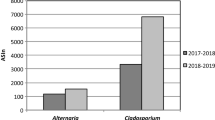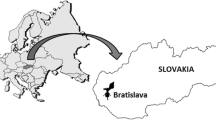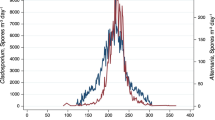Abstract
Introduction Fungal spores constitute an important fraction of bioaerosols in the atmosphere. Objectives To analyse the content of Alternaria and Cladosporium spores in the atmosphere of Beja and the effect of meteorological conditions on their concentrations. Methodology The daily and hourly data of Alternaria and Cladosporium fungal spores concentration in the atmosphere of Beja were monitored from April 12, 2012 to July 30, 2014, based on the Portuguese Aerobiology Network methodology. The influence of meteorological conditions on the studied types of fungal spore concentrations was assessed through Spearman’s correlation analysis. Results During the study period, 20,741 Alternaria spores and 320,862 Cladosporium spores were counted. In 2013, there were 5,822 Alternaria spores and 123,864 Cladosporium spores. The absolute maximum concentrations of Alternaria and Cladosporium spores were recorded on November 8, 2013, with 211 and 1301 spores/m3, respectively. Temperature, insolation and wind direction parameters showed a positive correlation with Alternaria and Cladosporium spore levels, while relative humidity and precipitation presented a negative correlation, which is statistically significant. Wind speed only showed a statistically significant positive correlation in terms of Alternaria spore levels. Conclusion Alternaria and Cladosporium spores are present in the atmospheric air of Beja throughout the year, with the highest concentration period occurring during spring and autumn. There was a clear effect of meteorological parameters on airborne concentrations of these fungal spores.


Similar content being viewed by others
References
Abu-Dieyeh, M., Barham, R., Abu-Elteen, K., Al-Rashidi, R., & Shaheen, I. (2010). Seasonal variation of fungal spore populations in the atmosphere of Zarqa area, Jordan. Aerobiologia, 26(4), 264–276.
Aira, M., Rodríguez-Rajo, F., Fernández-González, M., Seijo, C., Elvira-Rendueles, B., Abreu, I., et al. (2013). Spatial and temporal distribution of Alternaria spores in the Iberian Peninsula atmosphere, and meteorological relationships: 1993–2009. International Journal of Biometeorology, 57(2), 265–274.
Aira, M. J., Rodríguez-Rajo, F., Fernández-González, M., Seijo, C., Elvira-Rendueles, B., Gutiérrez-Bustillo, M., et al. (2012). Cladosporium airborne spore incidence in the environmental quality of the Iberian Peninsula. Grana, 51(4), 293–304.
Aira, M., Rodríguez-Rajo, F., & Jato, V. (2008). 47 Annual records of allergenic fungi spore: predictive models from the NW Iberian Peninsula. The Annals of Agricultural and Environmental Medicine, 15(1), 91–98.
Damialis, A., & Gioulekas, D. (2006). Airborne allergenic fungal spores and meteorological factors in Greece: Forecasting possibilities. Grana, 45(2), 122–129.
Galán, C., Smith, M., Thibaudon, M., Frenguelli, G., Oteros, J., Gehrig, R., et al. (2014). Pollen monitoring: minimum requirements and reproducibility of analysis. Aerobiologia, 30(4), 385–395.
Grinn-Gofron, A., & Bosiacka, B. (2015). Effects of meteorological factors on the composition of selected fungal spores in the air. Aerobiologia, 31(1), 63–72.
Grinn-Gofrón, A., & Strzelezak, A. (2013). Changes in concentration of Alternaria and Cladosporium spores during summer storms. International Journal of Biometeorology, 57(5), 759–768.
Hasnain, S. M., Al-Frayh, A., Gad-el-Rab, M. O., & Al-Sedairy, S. (1998). Airborne Alternaria spores: potential allergic sensitizers in Saudi Arabia. Annals of Saudi Medicine, 18, 497–501.
Heinzerling, L., Burbach, G. J., Edenharter, G., Bachert, C., Bindslev-Jensen, C., Bonini, S., et al. (2009). GA2LEN skin test study I: GA2LEN harmonization of skin prick testing: Novel sensitization patterns for inhalant allegens in Europe. Allergy, 64, 1498–1506.
Herrero, B., Fombella-Blanco, M. A., Fernández-González, D., & Valencia Barrera, R. (1996). The role of meteorological factors in determining the annual variation of Alternaria and Cladosporium spores in the atmosphere of Palencia, 1990–1992. International Journal of Biometeorology, 39, 139–142.
Ianovici, N., Maria, C., Radutoiu, M., Hanis, A., & Tudorica, D. (2013). Variation in airborne fungal spore concentrations in four different microclimate regions in Romania. Notulae Botanicae Horti Agrobotanici Cluj-Napoca, 41(2), 450–457.
IPMA. (Acedido Novembro 2016). Instituto Português do Mar e Atmosfera. Obtido de Instituto Português do Mar e Atmosfera: http://www.ipma.pt/pt/oclima/normais.clima/1971-2000/002.
Jato, V., Rodríguez-Rajo, F. J., Alcázar, P., De Nuntiis, P., Galán, C., & Mandrioli, P. (2006). May the definition of pollen season influence aerobiological results? Aerobiologia, 22, 13–25.
Kauffman, H. F., Tomee, J. F., Van Der Werf, T. S., De Monchy, J. G., & Koeter, G. K. (1995). Review of fungus-induced asthmatic reactions. American Journal of Respiratory and Critical Care Medicine, 151(6), 2109–2116.
Kurkela, T. (1997). The number of Cladosporium conidia in the air in different weather conditions. Grana, 36(1), 54–61.
Lacey, J. (1981). Aerobiology of conidial fungi. In G. Cole & B. Kendrick (Eds.), biology of conidial fungi (Vol. 1, pp. 273–416). New York: Academic.
Linares, C., Belmonte, J., Canela, M., Guardia, C. D., Alba-Sanchez, F., Sabarieg, S., et al. (2010). Dispersal patterns of Alternaria conidia in Spain. Agricultural and Forest Meteorology, 150, 1491–1500.
Maya-Manzano, J. M., Fernández-Rodríguez, S., Hernández-Trejo, F., Díaz-Pérez, G., Gonzalo-Garijo, A., Silva-Palacios, I., et al. (2012). Seasonal Mediterranean pattern for airborne spores of Alternaria. Aerobiologia, 28(4), 515–525.
Nunes, C., Câmara, I., Ferreira, M., Almeida, M., Gaspar, Â., Loureiro, C., et al. (2008). Fungos na atmosfera de Portugal. Revista Portuguesa de Imunoalergologia, 16(4), 377–394.
O`Hollarem, M. T., Yunginger, J. W., Offord, K. P., Somers, M. J., et al. (1991). Exposure to an aeroallergen as a possible precipitating factor in respiratory arrest in young patients with asthma. New England Journal of Medicine, 324(6), 359–363.
Oliveira, M., Abreu, I., Ribeiro, H., & Delgado, L. (2007). Esporos fúngicos na atmosfera da cidade do Porto e suas implicações alergológicas. Revista Portuguesa de Imunoalergologia, 15(1), 61–85.
Oliveira, M., Ribeiro, H., & Abreu, I. (2005). Annual variation of fungal spores in the atmosphere of Porto: 2003. Annals of Agricultural and Environmental Medicine, 12(2), 309–315.
Oliveira, M., Ribeiro, H., Delgado, J., & Abreu, I. (2009a). Seasonal and intradiurnal variation of allergenic fungal spores in urban and rural areas of the North of Portugal. Aerobiologia, 25(2), 85–98.
Oliveira, M., Ribeiro, H., Delgado, J., & Abreu, I. (2009b). The effects of meteorological factors on airborne fungal spore concentration in two areas differing in urbanisation level. International Journal of Biometeorology, 53(1), 61–73.
Reyes, E., Cruz, D., Merino, E., & Sánchez, J. (2009). Meteorological and agricultural effects on airborne Alternaria and Cladosporium spores and clinical aspects in Valladolid (Spain). Annals of Agricultural and Environmental Medicine, 16(1), 53–61.
Rodríguez-Rajo, F., Iglesias, I., & Jato, V. (2005). Variation assessment of airborne Alternaria and Cladosporium spores at different bioclimatical conditions. Mycological Research, 109(4), 497–507.
Sabariego, S., Díez, A., & Gutiérrez, M. (2007). Monitoring of airborne fungi in Madrid (Spain). Acta Botanica Croatica, 66(2), 117–126.
Sabariego, S., Guardia, C. D., & Alba, F. (2000). The effect of meteorological factors on the daily variation of airborne fungal spores in Granada (southern Spain). International Journal of Biometeorology, 44, 1–5.
Simon-Nobbe, B., Denk, U., Pôll, V., Rid, R., & Breitenbach, M. (2008). The Spectrum of Fungal Allergy. International Archives of Allergy and Immunology, 145, 58–86.
Smith, E. (1984). Sampling and identifying allergenic pollens and molds (Vol. I). San Antonio, Texas: Blewstone Press.
Smith, E. G. (1986). Sampling and Identifying Allergenic Pollens and Molds (Vol. II). San Antonio, Texas: Blewstone Press.
Targonski, P., Persky, V., & Ramekrishnan. (1995). Effect of environmental molde on risk of death from asthma durind the pollen season. Journal of Allergy and Clinical Immunology, 95, 955–961.
Acknowledgements
The authors would like to thank University of Évora and Unidade Local de Saúde do Baixo Alentejo for their collaboration in this project, Sociedade Portuguesa de Alergologia e Imunologia Clínica for the loan of the collector and, lastly, Beja Air Base No. 11, which kindly provided data regarding the meteorological parameters. A special thanks to teacher Rui Brandão, who designed the project from the beginning. This research was approved by the institution’s ethics committee, and the authors declare that they do not have any type of conflict of interest. This research did not receive any specific grant from funding agencies in the public, commercial or not-for-profit sectors.
Author information
Authors and Affiliations
Corresponding author
Rights and permissions
About this article
Cite this article
Almeida, E., Caeiro, E., Todo-Bom, A. et al. The influence of meteorological parameters on Alternaria and Cladosporium fungal spore concentrations in Beja (Southern Portugal): preliminary results. Aerobiologia 34, 219–226 (2018). https://doi.org/10.1007/s10453-018-9508-8
Received:
Accepted:
Published:
Issue Date:
DOI: https://doi.org/10.1007/s10453-018-9508-8




